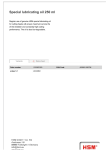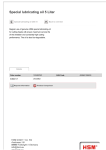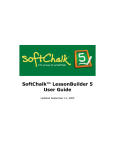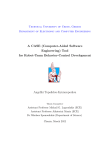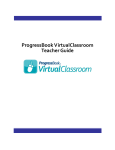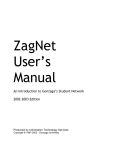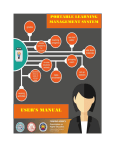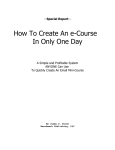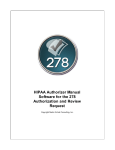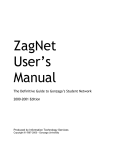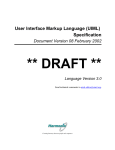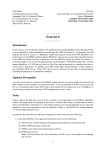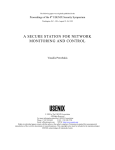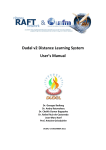Download Open eClass 2.1
Transcript
Open eClass 2.1 Asynchronous eLearning Platform Student Manual The Open eClass platform is a complete Course Management System. It is the solution offered by the Greek Academic Network GUnet to support Asynchronous eLearning Services. It is mainly designed, developed and supported by the GUnet Asynchronous eLearning Group and is distributed for free as open-source software. Title: Student Manual (Open eClass 2.1) Date: September 2008 Copyright: GUnet Asynchronous eLearning team Authors: Constantinos Tsibanis, Dimitra Kralli, Emmanouela Patiniotaki Contact: [email protected] Open eClass 2.1 - Asynchronous eLearning Platform Table of Contents TABLE OF CONTENTS................................................................................................................................ 3 1. INTRODUCTION ................................................................................................................................ 5 2. PLATFORM REGISTRATION ......................................................................................................... 6 2.1 APPLICATION FOR STUDENT ACCOUNT .........................................................................................................................................6 2.1.1 2.2 Student Registration (Automatically Account Creation).....................................................................................................7 ALTERNATIVE STUDENT ACCOUNTS .............................................................................................................................................8 2.2.1 Student Registration through LDAP account ......................................................................................................................8 2.2.2 Student Registration through IMAP, POP3 Authentication................................................................................................8 2.2.3 Student Registration through External Database (MySQL) ...............................................................................................8 2.3 USER LOGIN ...................................................................................................................................................................................9 3. USER PORTFOLIO........................................................................................................................... 10 3.1 MODIFY YOUR PROFILE ............................................................................................................................................................... 11 3.1.1 Deleting an Account.......................................................................................................................................................... 11 3.1.2 Changing Password.......................................................................................................................................................... 11 3.2 COURSE REGISTRATION ............................................................................................................................................................... 12 3.3 MY CALENDAR ............................................................................................................................................................................ 12 3.4 PERSONAL PORTFOLIO ANALYTIC VIEW ...................................................................................................................................... 13 3.5 SEARCH........................................................................................................................................................................................ 13 3.6 EXIT ............................................................................................................................................................................................. 13 4. PLATFORM’S ECOURSES ............................................................................................................. 14 4.1 COURSE DESCRIPTION ................................................................................................................................................................. 14 4.2 AGENDA....................................................................................................................................................................................... 15 4.3 DOCUMENTS ................................................................................................................................................................................ 15 4.4 ANNOUNCEMENTS ....................................................................................................................................................................... 16 4.5 FORUM ......................................................................................................................................................................................... 16 4.6 LINKS ........................................................................................................................................................................................... 17 4.7 COURSE ASSIGNMENTS ............................................................................................................................................................... 18 4.8 USER GROUPS .............................................................................................................................................................................. 19 Group Assignment............................................................................................................................................................................... 20 4.9 5. EXERCISES ................................................................................................................................................................................... 20 4.10 VIDEO ..................................................................................................................................................................................... 21 4.11 DROPBOX MODULE ................................................................................................................................................................ 22 4.12 QUESTIONNAIRES ................................................................................................................................................................... 22 4.13 TELECONFERENCING .............................................................................................................................................................. 23 4.14 LEARNING PATH ..................................................................................................................................................................... 24 4.15 WIKI MODULE ........................................................................................................................................................................ 25 PLATFORM’S SUPPORT ................................................................................................................ 26 Student User Manual - 3 - Open eClass 2.1 - Asynchronous eLearning Platform Student User Manual - 4 - Open eClass 2.1 - Asynchronous eLearning Platform 1. Introduction The Open eClass platform is a complete Course Management System and it is the solution offered by the Greek Academic Network GUnet to support asynchronous eLearning services. It has been designed with the intention to support the conventional educational process. It is actively supported by GUnet and is distributed for free as opensource software. The introduction of elearning into the traditional teaching process provides new capabilities and allows new means of interaction between students and teachers. At the same time, it supports the electronic management, storage and presentation of teaching materials, transcending limitations of space and time and creating the necessary conditions for a dynamic learning environment. The platform is accessible via a simple web browser without any demands of specialized technical knowledge. Pic.1. Open eClass platform This manual is a useful guide for the registered platform student users, in which one can find analytical presentations of platform operations and potentiality. More specifically, what is described is the student participation in the platform (student registration, user profile, eCourse participation, access to educational material, electronic assignment submission, eCourse agenda and informational announcements, following a learning path, working in groups, discussion forums, self-evaluation tests, eCourse wikis, etc). Student User Manual - 5 - Open eClass 2.1 - Asynchronous eLearning Platform 2. Platform Registration On entering the Open eClass platform with a Student identity, you will immediately be allowed to explore a new dynamic learning environment. What is more, you will be able to gain access to all available eCourses (open eCourses, demanding registration eCourses, as well as “closed courses” that you have been invited/registered to by the eCourse teacher). In order to do that, you will need to create a new student account: Select: “User Registration” from the platforms main page. This selection leads automatically to a) “Application for Creating a Student Account” or b) “Student Account Creation” Then click on: “new student account” Pic.2. Student Registration Note that the appearance of the student account application form or the student account creation form depends on the administrator’s policy. 2.1 Application for Student Account In case the administrator has established a policy not allowing automatic student registration to the platform, then you have to fill the student accont application form with your personal details. More analytically, you will need to fill in: 1. Your personal information: Name, Surname, Phone number and e-mail address). 2. The username you wish to have, which is the one you will be identified with by the system. 3. Note: you are advised to use Latin characters for the username and no special characters; only numbers or/and letters. 4. Comments, where you can stress the reasons for registering to the platform as a student. 5. Select the School or Faculty you belong to from the list and click on the “Send” button. Student User Manual - 6 - Open eClass 2.1 - Asynchronous eLearning Platform The platform administrator will receive your application and after processing it you will receive a registering comfirmation email message, which will refer to your log in username and password. In case your personal information does not accurately provide your identity or state the reason why you applied, the administrator will contact you by email or phone call to get more information so as to create your account. 2.1.1 Student Registration (Automatically Account Creation) If the administrator has set a policy that allows automatic student registration to the platform, filling in the registration form will automatically create your student account. More analytically, you will have to fill in: 1. Your personal information: Name, Surname, Phone number and email address, as well as your Student Identity Number. 2. The username and password you want to have. They will be used by the system so as to identify you. Your password has to be typed twice for confirmation. Note: it is suggested that the username and password should be written in Latin characters and not include special characters; only numbers and/or letters. 3. Select the Scholl or Faculty you belong to from the list. 4. Finally, click on the Registration button. Pic.3. Student Account Registration The system will check your personal information and automatically create your personal student account. At the same time you will be introduced to your personal portfolio in the platform and allow you to register in all available eCourses. Student User Manual - 7 - Open eClass 2.1 - Asynchronous eLearning Platform 2.2 Alternative Student Accounts If the installation of the Open eClass platform you use supports users’ authentication through LDAP, IMAP, POP3 or External MySQL, then the “Student Registration” link leads to a choice of alternative registration means. Pic.4. Selecting a way to register as a student user 2.2.1 Student Registration through LDAP account If you have an account in your Institute LDAP Directory Service then click on “New Account (using an LDAP account)”. More analytically: (1) Fill in the email and password you have in the LDAP Service. In that way, you will have access to the Open eClass platform using your email address and the already existing password. (2) Select the LDAP Server of your Institute, (3) Choose the School or Faculty you belong to from the list (4) Click on the “Registration” button If the information you have inserted is correct, the platform will ask you to confirm the specific action. Click on the “Add” button In any case, you will receive an email message confirming your registration and clearly stating that user authentication through LDAP Service has been exploited for access to the Open eClass platform. 2.2.2 Student Registration through IMAP, POP3 Authentication If you have a POP3 or IMAP email account, you can register through that account. Fill in the application form with the username and password you use in the database and then click on the “Registration” button. 2.2.3 Student Registration through External Database (MySQL) If you have an account in an external MySQL database, you can register to the platform through that account, too. Fill in the application form with the username and password you use in the database and then click on the “Registration” button. Student User Manual - 8 - Open eClass 2.1 - Asynchronous eLearning Platform 2.3 User Login After you have registered an account with Student rights on the platform, you will have to type your username and password every time you enter it. Pic.5.User Login By doing that you will have a student user access in all available eCourses modules, that are analytically presented below. If you forget you your password, you have to click on the “Forgot your password?” link and follow the instructions. Please notice that the instructions will be sent to your email address. Student User Manual - 9 - Open eClass 2.1 - Asynchronous eLearning Platform 3. User Portfolio By logging in the platform (inserting your username and password), you will enter into your personal portfolio, an area that allows you to organize and control your eCourses participation in the platform. Pic.6a. Analytic Student-User Portfolio Pic.6b. Simple Student-User Portfolio On the left menu, you are provided a series of choices concerning eCourse registration, editing you personal profile, your personal eCourse calendar, personal statistics etc, which will be presented below. On the right column there is a list of attended eCourses. In the courses you attend as a student, there is an “unregister” choice in the course, so that you can delete it from the list. If you click on the title of the course you enter it with the rights of a student-user. Finally, in the analytic student portfolio view you are provided with information concerning your eCourses, your assignments deadlines, your latest documents, your eCourses latest announcements and the latest submission in your eCourses discussion forums. Student User Manual - 10 - Open eClass 2.1 - Asynchronous eLearning Platform 3.1 Modify your profile Choose “modify your Profile” from the left column of the user portfolio, and change your personal information, like username, password, email address, portfolio’s language and view. Type the new information in the corresponding fields and click on “Modify”. At the same time, you will be able to view your last ten visits to the platform, at the bottom of the screen, below your personal information. Pic.7. Change of profile Note for LDAP, IMAP, POP3 users: LDAP, IMAP. POP3 users cannot make any changes to their profile. They can change only the portfolio’s default language and view. 3.1.1 Deleting an Account You are also delete your account from the platform if you choose the “Delete Account” link. However, you first need to unregister from all the eCourses you have been attending and then click on the “Delete Account” link on top of the screen. You will be asked to confirm this before your account has been deleted. 3.1.2 Changing Password Lastly, you are also given the opportunity to change your password in order to access the platform. You need to type the old and the new password and then click on the “Modify” button. Student User Manual - 11 - Open eClass 2.1 - Asynchronous eLearning Platform Pic.8. Changing Password 3.2 Course registration If you click on “Course Registration” on the left column in your personal portfolio, you will be transferred to the platform’s eCourses list, from which you can select the eCourses you want to register in your personal portfolio. The course list that appears includes the courses available, grouped by the Faculty they belong to. First, select the Faculty and then choose the courses you wish to attend by marking (√) the checkbox next to their title. After having made your choices, click the “Change Submission” button to complete your eCourses list. Your personal Portfolio will now include all the selected courses in the “Attended Courses” list. Click on any course title you want, so as to enter the eCourse area with student’s rights. Pic.9. Course list 3.3 My Calendar If you click on “My Calendar” on the left menu of your personal portfolio, you can see a calendar of events that have been included in all the course agendas you have registered for. In that way, you can better organize your (weekly/monthly) programme in the platform. Pic.10. My Calendar Student User Manual - 12 - Open eClass 2.1 - Asynchronous eLearning Platform 3.4 Personal portfolio analytic view If you choose analytic view in your personal portfolio settings you are provided with information concerning your eCourses, your assignments deadlines, your latest documents, your eCourses latest announcements and the latest submission in your eCourses discussion forums. So, you are informed for all the eCourses that you attend without needing to check each eCourse separately for updates. Pic.11. Analytic Student-User Portfolio 3.5 Search If you click on the “Advanced Search” button at the top, you can search on the platform courses based on the title of the course, any keywords, the teacher or the course code. It should be noted that only courses in which you are allowed access (“open courses” or “registration open courses”) will be included in the search. What is more, you can do a simple search by typing the text you like and click on “OK”.Note that you can also search from the course homepage. In this case, the search will be done only through the specific eCourse educational material. 3.6 Exit Finally, you can sign out of the Open eClass platform, by clicking on “Exit” on the right side, at the top of the screen. In that way, you inform the platform about the end of your session and avoid the inconvenience of someone else using the platform with your account (username or password). This action is especially important for the safety of your eCourses when using public computers. Student User Manual - 13 - Open eClass 2.1 - Asynchronous eLearning Platform 4. Platform’s eCourses The eCourse is the core part of the Open eClass platform. Each course is an autonomous entity in the platform, which integrates a series of learning tools (modules). The eCourse is, in fact, a modular structure, which is organized and maintained by the teacher in charge. More specifically, the student user eCourse home screen has the following view. Pic.12. eCourse homepage – student view On the eCourse home screen, there is a short description, in which basic information (title, code, responsible teacher, department etc) are reposted. Also, there is an “email” hyperlink, which allows registered student-users, who have defined their email address in their profile, to communicate with the course teacher via email. On the left, there is a menu with all the active eLearning tools (modules) provided for the eCourse by the teacher in charge. 4.1 Course Description Course description is a module providing useful information about the course syllabus, like course short description, course ID, goals and educational material, evaluation and testing, supportive educational material and activities and any other information the teacher values as being important. Pic.13.Course Description Student User Manual - 14 - Open eClass 2.1 - Asynchronous eLearning Platform 4.2 Agenda The Agenda module informs you about the most important events of the course in a chronological order (conferences, meetings, evaluations, etc). You have the choice of altering the presentation order of events (recent-older), by clicking on the “Reverse presentation order” that is on top action bar. Furthermore, the events presented in the agenda may include hyperlinks which can be clicked to transfer you to the associated content. Pic.14. Agenda 4.3 Documents The module “Documents” is the area where the educational material of the course is stored, organized and presented. More specifically, this module provides a useful file organization and grouping mechanism for educational material (texts, presentations, pictures, diagrams, etc) through a folder, sub-folder system. This tool works as a common file manager tool, allowing the responsible teacher to organize all the available course documents in folders. Pic.14. Documents Module In order to open a course document file click on the file title and then click on “Open”. If you want to download and save a course document file to your local pc click on the file title and then click on “Save”, and type the folder you want to store it in. Transfer will start immediately. An explanatory text (comment) may follow below the file name, so that you can determine its content without opening it before. Student User Manual - 15 - Open eClass 2.1 - Asynchronous eLearning Platform 4.4 Announcements The Announcements module allows registered users’ enlightenment on specific course issues. At the same time, it allows course teachers to send announcements to registered students, who have defined their email address in their profile, via email. (“Modify your Profile” in user’s portfolio). Pic.15. Announcements 4.5 Forum The eCourse discussion forum is a teacher - student interaction module. The platform offers the opportunity to create forums, allowing participation to all registered in the course users (students and teachers). Pic.16. Forums Furthermore, you can see the last insert in every forum subject, the number of forum subjects and the number of messages. Clicking on a topic you can participate in the units it includes. More specifically, you can watch all topics discussed , the topic sender, the date the message was posted, the answers sent for the specific topic, and the number of times it has been read, as well as the date and time when the last answer was sent. Pic.17. Answer to a forum Student User Manual - 16 - Open eClass 2.1 - Asynchronous eLearning Platform If you want to read messages in a topic, click on the topic title and you will see its contents. Messages are read downwards and at this stage you have some choices to make. In order to send an answer click on the “Answer” link and type your message in the textbox and then click “Submit” to send your message or click on “Cancel” if you do not want to send it. If you want to start a new conversation, click on “New Topic”. Type the topic of the conversation and the message in the corresponding textboxes. In case of a mistake you will view an error message. Sometimes, it is necessary to use the “Go Back” button of the browser so as to make the error message disappear. Pic.18. Submission of a new topic If the course teacher has added you in a group (see Groups), it is possible that there will be a folder with group discussion forums. These forums are usually closed to group members depending on the teacher’s decision. “My Team” will appear next to your group forum. If groups are closed, you can click on the groups you belong to only. 4.6 Links The Links module gives you the opportunity to add useful Internet resources and categorize them at the same time. They have been organized by the course teacher and each one of them has a title and a description with further information. Pic.19. Useful Links The links chosen by the teacher may be grouped. You can choose “Show” if you want the links of a group to appear on screen and “Hide” if you do not want them to appear. Student User Manual - 17 - Open eClass 2.1 - Asynchronous eLearning Platform 4.7 Course Assignments The Course Assignments module is a very useful tool since it allows the electronic admission, submission and evaluation of course assignments. More specifically, it allows registered student users to upload electronically their assignments in the platform until the submission date and then see their grade, after the teacher has graded them. If you click on “Course Assignments”, you can see the assignments placed on the platform by the course teacher, the deadline for submission, and the grades, if the assignments are evaluated by the teacher. Pic.20. Course Assignments If you click on the assignment title, you will be able to see more information about the assignment, like the title and description of the assignment, the starting date and the assignment submission deadline, the type of assignment, individual or group one. You can upload your assignment from your pc to the platform. Pic.21 .Assignment upload • Click on “Browse”, navigate yourselves in your local driver and select the file you want to upload • You can type a description of your assignment as well • Click on the “Send Assignment” link The uploading process starts and you will soon be able to see your assignment document in the assignment submitted list. Notice that you cannot delete documents you have already uploaded, but you can upload revised versions of your assignments, so as to replace the previous ones, until the deadline, you are otherwise denied the opportunity to submit your assignment. Student User Manual - 18 - Open eClass 2.1 - Asynchronous eLearning Platform 4.8 User Groups Another course module that allows cooperation and interaction among the students is the User groups. A group of users is a team of course registered students who share the same forum and the same file and assignment uploading area. If the course teacher has set a number of user groups, you can click on their group’s name to see: Pic.22. User Groups • The groups of users organized by the teacher • The number of registered users in each group • The maximum number of users possible to be registered in that team • If you belong to a team, there is a “my team” sign next to the group title If there is a “Registration” option next to the group names, these teams are not full and you can register. If you have registered to a team which is not full of members, in order to participate: • Click on the “Registration” option next to the group name you want to participate in • Then, click on “Add me to the Group” Pic.23. User add to group Since you are a member of a group, you are provided a communal document area so as to share files with other members of the group, as well as a group forum. The document area allows you to upload, rename, delete and remove files, create folders and subfolders so as to organise your documents in a better way. Student User Manual - 19 - Open eClass 2.1 - Asynchronous eLearning Platform Group Assignment If you want to submit a group assignment you have to upload your group’s assignment file to the common group document area and the click on “Publish” and fill in all the form fields very carefully. Any member of the group can submit a group assignment file. Pic.24. Group assignment 4.9 Exercises This module provides self-evaluation exercises for students, which have been created by the course teacher. Its basic aim is students’ training on course material. Some exercises may have a time limit or maximum number of attempts (teacher’s choice). Pic.25. Tasks More specifically, if you want to take a self-evaluation exercise, choose the one you want by clicking on its name. Questions appear automatically (multiple choices, gap filling, column matching), based on the course teacher’s choices. In case of multiple choices, you choose the answer you regard correct by clicking on the selection box next to it. In case of gap-filling, you type the answer you regard correct in the blank and in case of column matching questions you choose the correct answers from the lists of options. After answering the questions, click on “Submit” and wait for the results page. Student User Manual - 20 - Open eClass 2.1 - Asynchronous eLearning Platform Your answers and total score appear on the results page. You can return to the course contents through the navigation bar on top of the page. It should be noted that you can solve a self-evaluation exercise as many times as you wish, since the course teacher is not informed about your results. Pic.26. Exercise results page 4.10 Video It is a module presenting multimedia educational material. There are two choices, video file or link to video that is stored in a VOD Server (Video on Demand) Server. These two choices are transparent for the students. Every video has a title and a short description. Pic.27. Video So, if you want to access the multimedia educational material that the course teacher has added in the eCourse video module, you have to click on the title of the video you want to watch, and the systems opens it with the associated video player (ex. Media player, QuickTime, Real player, etc). Student User Manual - 21 - Open eClass 2.1 - Asynchronous eLearning Platform 4.11 Dropbox Module The Dropbox module is a collaboration tool used by teachers and students to exchange course files. You can send and receive any type of text files, pictures or presentations. In order to send a file, click on “Upload File”. In the file upload form that appears first select the file you want to send from your computer using “Browse” and type a short description. Then, select the file receiver from the course teachers list and click on “Send”. If you want to send the file to more than one teacher (if any), click on the teachers names holding CTRL. Pic.28. Dropbox - File Exchange form The Dropbox module includes two File Exchange lists. The Inbox list includes the files you have received by the course teacher, along with some further information concerning the file (sender, description, file size and date it has been sent), and the Sent list which contains files you have sent to the teacher. You can delete all or some of the files from the list by clicking on the delete icon. Note that, the file is not deleted from the platform’s database, only from the Dropbox file list. 4.12 Questionnaires Questionnaire is a new module providing interaction between teachers and students. Course teacher create poll questionnaires about the course in order to have feedback from the students. If you want to participate in a questionnaire click on the questionnaire’s title from the list, and all the questionnaire’s questions appear so that you can answer them. Student User Manual - 22 - Open eClass 2.1 - Asynchronous eLearning Platform Pic.29. Questionnaires List You answer the questions you by selecting the corresponding answer box and then you click on the “Next” button to proceed to the next questions. When you have answered all the available questions you press the submit button. Pic.30. Participation in a Course Questionnaire You cannot participate in the same poll again. For your own help there is a “You have previously participated” sign in all the questionnaires that you have already answer. 4.13 Teleconferencing The Teleconferencing is a message exchange module (chat). Students can type a message and click on “>>” to exchange messages with other course register users. This module offers real time communication for course participants regardless the special limiting factor. Pic.31. Teleconference - Chat Student User Manual - 23 - Open eClass 2.1 - Asynchronous eLearning Platform 4.14 Learning Path The “Learning Path” module incorporates into the Open eClass the SCORM prototype technology (Sharable Content Object Reference Model). SCORM is a standard for webbased eLearning. It defines how the individual instruction elements are combined and sets conditions to the platform for using the content. This module offers the opportunity to the course teacher to create a sequence of steps (learning path) as learning activities, which should be followed by the students. Teacher creates learning paths using the course material (course documents, selfevaluation exercises, Internet useful links, course description etc.) or he can insert a SCROM type object, as a specific learning action sequence of an eCourse. Through this module, the student can be navigated in the available educational material and follows the steps as set by the teacher, in a specific order. Also provides platform the ability to watch learning progress, time and evaluation of the student in the several learning path steps. The learning path consists of units (at least one). The units are independent learning objects. In the current Open eClass platform, these tools may belong to one of the following five categories: Documents: Documents available in the course “Documents” tool. They may be anything you have created as long as it is available through the “Documents” tool. Exercises: Self-evaluation exercises which are available on the course “Exercises” tool. Links: Useful links available through the course “links” tool. Course Description: The description that is available through the “Course Description” tool (description, course content, educational activities, books, etc). SCROM type content: These units are the result of inserting course packages that are compatible to the SCROM standard. Their contents depend on what has been included in them by the creator, which is documents, exercises, links, text and anything else that is approachable according to the SCROM definition, so that the platform can use it appropriately. Pic.32 Learning Paths list Student User Manual - 24 - Open eClass 2.1 - Asynchronous eLearning Platform In order to start a learning path, you need to click the learning path title from the list. At first, each learning path progress and course progress will have a proportion of 0%. After all learning paths of a course have been completed; its progress will be at 100%. Pic.33. Learning Path Units Pic.34. Learning Path Actions There are some useful information and options: • you can move on to the next learning path If you click on the arrows unit or return to the previous one. • The signs allow you to see the unit on the whole screen or remain in frames. • If you click on the sign, you can return to the learning paths list and not complete the learning path at that particular moment. • If you have successfully completed the unit, there is a check next to the unit name. • Also when a learning path unit is completed, progress can be seen on the corresponding bar, while its indication is 100% when all of them have been completed. 4.15 Wiki Module The Wiki module is a new collaboration tool introduced in the current version of the platform Open eClass. Wiki is a course tool that allows register users (teachers and students) to create and edit Web page content. More specifically Wiki supports Student User Manual - 25 - Open eClass 2.1 - Asynchronous eLearning Platform hyperlinks and has simple text syntax for creating new pages and cross links between internal pages on the fly. Pic.35. Course Wiki list In order to participate in a course Wiki, click on the "Wiki title" link from the course wiki list. Then click on “edit this page” and make any changes you want. To get the list of the last modified pages click on the link "Page history". Please note that you can create easily cross links between internal pages by marking the linked text and clicking the button link or by placing the marked text between square brackets (ex. the [solution] of this problem is…). The word solution is a link. 5. Platform’s Support The Open eClass is distributed for free as open-source software. Every platform installation is supported by the local administrators who are responsible for the platform’s operation, as well as the service of registered users’ (teachers, students) requests. Student User Manual - 26 -


























